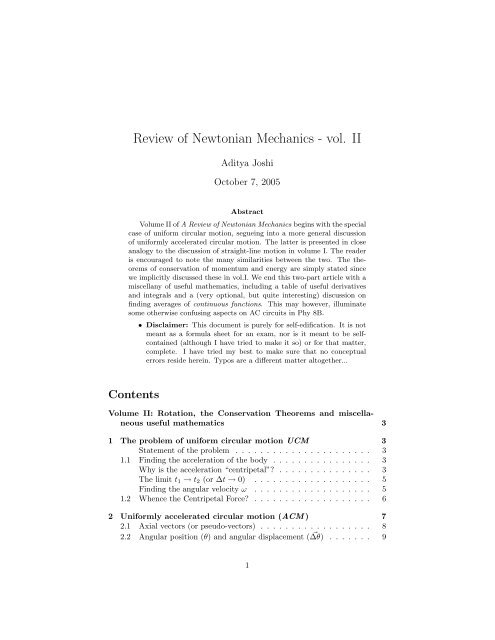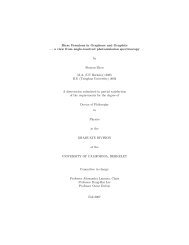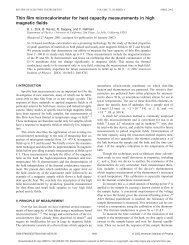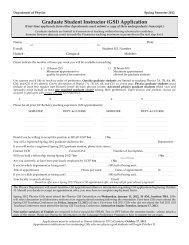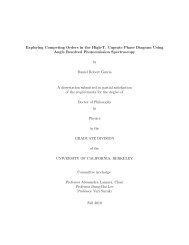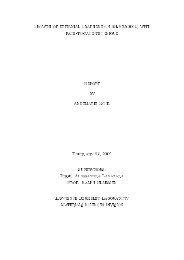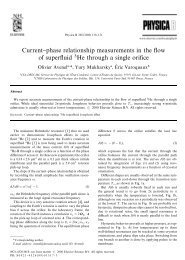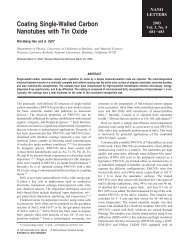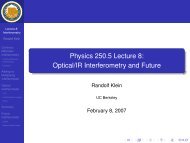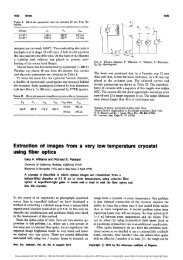Review of Newtonian Mechanics - vol. II - Physics
Review of Newtonian Mechanics - vol. II - Physics
Review of Newtonian Mechanics - vol. II - Physics
You also want an ePaper? Increase the reach of your titles
YUMPU automatically turns print PDFs into web optimized ePapers that Google loves.
<strong>Review</strong> <strong>of</strong> <strong>Newtonian</strong> <strong>Mechanics</strong> - <strong>vol</strong>. <strong>II</strong><br />
Aditya Joshi<br />
October 7, 2005<br />
Abstract<br />
Volume <strong>II</strong> <strong>of</strong> A <strong>Review</strong> <strong>of</strong> <strong>Newtonian</strong> <strong>Mechanics</strong> begins with the special<br />
case <strong>of</strong> uniform circular motion, segueing into a more general discussion<br />
<strong>of</strong> uniformly accelerated circular motion. The latter is presented in close<br />
analogy to the discussion <strong>of</strong> straight-line motion in <strong>vol</strong>ume I. The reader<br />
is encouraged to note the many similarities between the two. The theorems<br />
<strong>of</strong> conservation <strong>of</strong> momentum and energy are simply stated since<br />
we implicitly discussed these in <strong>vol</strong>.I. We end this two-part article with a<br />
miscellany <strong>of</strong> useful mathematics, including a table <strong>of</strong> useful derivatives<br />
and integrals and a (very optional, but quite interesting) discussion on<br />
finding averages <strong>of</strong> continuous functions. This may however, illuminate<br />
some otherwise confusing aspects on AC circuits in Phy 8B.<br />
• Disclaimer: This document is purely for self-edification. It is not<br />
meant as a formula sheet for an exam, nor is it meant to be selfcontained<br />
(although I have tried to make it so) or for that matter,<br />
complete. I have tried my best to make sure that no conceptual<br />
errors reside herein. Typos are a different matter altogether...<br />
Contents<br />
Volume <strong>II</strong>: Rotation, the Conservation Theorems and miscellaneous<br />
useful mathematics 3<br />
1 The problem <strong>of</strong> uniform circular motion UCM 3<br />
Statement <strong>of</strong> the problem . . . . . . . . . . . . . . . . . . . . . . 3<br />
1.1 Finding the acceleration <strong>of</strong> the body . . . . . . . . . . . . . . . . 3<br />
Why is the acceleration “centripetal”? . . . . . . . . . . . . . . . 3<br />
The limit t 1 → t 2 (or ∆t → 0) . . . . . . . . . . . . . . . . . . . 5<br />
Finding the angular velocity ω . . . . . . . . . . . . . . . . . . . 5<br />
1.2 Whence the Centripetal Force? . . . . . . . . . . . . . . . . . . . 6<br />
2 Uniformly accelerated circular motion (ACM ) 7<br />
2.1 Axial vectors (or pseudo-vectors) . . . . . . . . . . . . . . . . . . 8<br />
2.2 Angular position (θ) and angular displacement ( ∆θ) ⃗ . . . . . . . 9<br />
1
2.3 Angular velocity (⃗ω) . . . . . . . . . . . . . . . . . . . . . . . . . 10<br />
2.4 Angular acceleration (⃗α) . . . . . . . . . . . . . . . . . . . . . . . 10<br />
2.5 Torque (⃗τ) and “Newton’s 2 nd law” analogue for rotation . . . . 10<br />
2.6 The Kinematic equations for constant angular acceleration . . . . 11<br />
3 Calculating torque in physics problems 11<br />
3.1 Method 1 - vector method . . . . . . . . . . . . . . . . . . . . . . 11<br />
3.2 Method 2 - scalar method . . . . . . . . . . . . . . . . . . . . . . 13<br />
4 The Conservation Theorems 14<br />
4.1 Momentum conservation . . . . . . . . . . . . . . . . . . . . . . . 14<br />
4.2 Energy conservation (now that’s a thought) . . . . . . . . . . . . 15<br />
5 Useful math formulae 15<br />
5.1 Commonly used derivatives in elementary physics . . . . . . . . . 15<br />
Differentiation Rules . . . . . . . . . . . . . . . . . . . . . . . . . 15<br />
Derivatives . . . . . . . . . . . . . . . . . . . . . . . . . . . . . . 15<br />
5.2 Commonly used integrals in elementary physics . . . . . . . . . . 16<br />
Integration Rules . . . . . . . . . . . . . . . . . . . . . . . . . . . 16<br />
Integrals . . . . . . . . . . . . . . . . . . . . . . . . . . . . . . . . 16<br />
Averages <strong>of</strong> functions . . . . . . . . . . . . . . . . . . . . . . . . . 16<br />
Average values <strong>of</strong> cos 2 x and sin 2 x over the interval [0, 2π] . . . . 17<br />
2
1 The problem <strong>of</strong> uniform circular motion UCM<br />
We will state this problem in a very simple way. Please note the logical order in<br />
which we proceed here. Specifically, note that we initially make no assumptions<br />
about forces acting on the body. Rather, we impose a certain kind <strong>of</strong> motion<br />
on the body and then proceed to calculate the kind <strong>of</strong> force necessary in order<br />
to create this motion. The centripetal force will arise naturally and will be<br />
born <strong>of</strong> necessity.<br />
Statement <strong>of</strong> the problem<br />
A body <strong>of</strong> mass M is constrained to move in a circle <strong>of</strong> radius R at a constant<br />
speed | −→ v | = v. It is vital that you realize that it is only the speed (v) which<br />
is constant. The direction <strong>of</strong> the velocity vector must be continually changing<br />
in order to stay on the curved path. The problem is to find the force needed to<br />
create this physical situation.<br />
Newton’s 2 nd Law (Vol.I, eq.5) relates the force to the acceleration by:<br />
−→ F = M · −→ a (1)<br />
Therefore, if we can find the acceleration that the body undergoes, eq.( 1)<br />
immediately tells us how much force is required (and in what direction) in order<br />
to keep the body moving in a circle.<br />
Since the velocity vector is changing with time (just the direction), the body<br />
is — by definition — undergoing an acceleration −→ a , which we wish to calculate<br />
(well...at least I do).<br />
1.1 Finding the acceleration <strong>of</strong> the body<br />
We begin by drawing a detailed sketch <strong>of</strong> the motion at two instants <strong>of</strong> time very<br />
close to each other (see fig. 1). The time difference is ∆t = t 2 −t 1 . The velocities<br />
at the two points <strong>of</strong> time are v 1 and v 2 and they are directed tangential to the<br />
circle. The direction <strong>of</strong> the velocity at any point on the circle is the direction<br />
the body is travelling at that instant.<br />
Why is the acceleration “centripetal”?<br />
To find the change in velocity ( −→ ∆v = −→ v 2 − −→ v 1 = −→ v 2 + (− −→ v 1 )), we just have to find<br />
the vector sum <strong>of</strong> −→ v 2 and (− −→ v 1 ). This is shown explicitly in fig. 1. Because <strong>of</strong> the<br />
symmetry (the fact that both vectors have the same length (same magnitude <strong>of</strong><br />
the velocity)), the vector sum (thick green arrow) is seen to point towards the<br />
center <strong>of</strong> the circle. It will do so for any pair <strong>of</strong> points on the circle. The vector<br />
sum is the change in velocity and so −→ ∆v points towards the center all the time.<br />
Now, the average acceleration between points 1 and 2 is just the rate at<br />
which the (vector) velocity is changing.<br />
−→<br />
−−→ ∆v<br />
a avg(1→2) =<br />
(2)<br />
∆t<br />
3
Figure 1: (a) Snapshot <strong>of</strong> motion at two times t 1 and t 2 very close to each other.<br />
(b) Finding ⃗ ∆v visually.<br />
So, the acceleration vector just inherits the direction from −→ ∆v. Therefore,<br />
the acceleration is “centripetal”, which means “center-seeking”. The radial unit<br />
vector (a direction vector that always points away from the center <strong>of</strong> the circle)<br />
is denoted by ˆr. So, we can denote the direction <strong>of</strong> the acceleration by −ˆr.<br />
To find −→ ∆v, note that the horizontal components <strong>of</strong> −→ v 2 and − −→ v 1 cancel each<br />
other and the vertical components add in the centripetal direction (the −ˆr direction).<br />
From the geometry, the vertical components are each equal to v cos(φ).<br />
So, we get:<br />
−→<br />
∆v = −→ v 2 + (− −→ v 1 )<br />
= (v cos(φ) + v cos(φ)) (−ˆr)<br />
= 2 v cos(φ)(−ˆr) = 2 v cos( π 2 − ∆θ )(−ˆr) . . . . . . which finally becomes :<br />
2<br />
−→<br />
∆v = −2 v sin( ∆θ )ˆr (3)<br />
2<br />
So, the average acceleration can be written as:<br />
4
−−→<br />
a avg(1→2) =<br />
−→<br />
∆v<br />
∆t<br />
∆θ<br />
2 v sin(<br />
The limit t 1 → t 2 (or ∆t → 0)<br />
2 )<br />
= − ˆr . . . (from eq. 3)<br />
∆t<br />
∆θ<br />
sin(<br />
2<br />
= −2 v ) ( ∆θ<br />
2 )<br />
( ∆θ<br />
2 ) ˆr . . . (just the usual trick)<br />
∆t<br />
[<br />
sin(<br />
∆θ<br />
2<br />
= − v<br />
)<br />
] [∆θ<br />
( ∆θ<br />
2 ) ∆t<br />
]<br />
ˆr (4)<br />
If the two instants <strong>of</strong> time are taken to be very close, then the angle ∆θ becomes<br />
very very small. The average acceleration (from eq. 4— in the limit that ∆t → 0<br />
and ∆θ → 0 (and t 1 → t 2 ))— becomes the instantaneous acceleration at time<br />
t 1 :<br />
But,<br />
Also,<br />
−→ a (t1 ) = − v Limit<br />
} {{ }<br />
(∆θ→0)<br />
[<br />
sin(<br />
∆θ<br />
2 )<br />
]<br />
( ∆θ<br />
2 )<br />
Limit<br />
} {{ }<br />
(∆t→0)<br />
[ ] ∆θ<br />
ˆr (5)<br />
∆t<br />
[<br />
sin(<br />
∆θ<br />
2<br />
Limit<br />
)<br />
]<br />
} {{ } ( ∆θ<br />
(∆θ→0)<br />
2 ) = 1 . . . (from calculus) (6)<br />
[ ] ∆θ<br />
Limit<br />
} {{ }<br />
= dθ<br />
∆t dt = ω (7)<br />
(∆t→0)<br />
Where, ω (pronounced ‘omega’)is the angular velocity <strong>of</strong> the body, i.e.<br />
the amount <strong>of</strong> angle (in radians) swept out by the body per unit time, i.e. the<br />
rate <strong>of</strong> change <strong>of</strong> angular position with respect to time.<br />
Using eq. 6 and eq. 7 in eq. 5, and generalizing t 1 to any time t, we obtain:<br />
[ ]<br />
−→ dθ<br />
a (t) = −v · 1 ˆr = −v ω ˆr (8)<br />
dt<br />
Finding the angular velocity ω<br />
We can use a very obvious fact here. The time taken (T) for the body to sweep<br />
out an angle 2π (i.e. the whole circle <strong>of</strong> radius R) at an angular speed ω should<br />
be the same as the time taken for it to cover the entire circumference (C = 2πR)<br />
5
at (linear) speed v. That’s quite a mouthful, so you might want to read it again.<br />
Since time = distance angle covered<br />
speed<br />
=<br />
angular speed<br />
, we have:<br />
T = 2π ω = 2πR<br />
v<br />
Simplifying this gives the very useful relation:<br />
ω = v R<br />
(9)<br />
Using eq. 9 in eq. 8 and noticing that the acceleration is constant in time,<br />
we finally obtain a formula for the centripetal acceleration <strong>of</strong> the body:<br />
−→ −v 2<br />
a = ˆr (10)<br />
R<br />
Along the way, we also define a useful quantity called frequency. The<br />
period <strong>of</strong> rotation was defined as the time (T) it took to move once around<br />
1<br />
the circle. So,<br />
T<br />
would mean the number <strong>of</strong> rotations made per second. This<br />
is the frequency (f). (Sometimes, you may find it denoted by the Greek letter<br />
[ν], pronounced ‘nu’ ). Refer back to eq. 9.<br />
f = 1 T = ω 2π =<br />
v<br />
2πR<br />
(11)<br />
1.2 Whence the Centripetal Force?<br />
Now, we are ready to answer the most important part <strong>of</strong> the problem — what<br />
kind <strong>of</strong> force is neeeded to make a body go in a circle at a constant speed v?<br />
Applying Newton’s 2 nd Law (eq. 1) to our rotating body, we obtain:<br />
So,<br />
−→ F = M<br />
−→<br />
( a<br />
) −v<br />
2<br />
= M<br />
R ˆr . . . (using eq. 10)<br />
)<br />
−→ F =<br />
(−M v2<br />
ˆr (12)<br />
R<br />
So, eq. 12 tells us that the force that causes this motion (constrained along<br />
a circle <strong>of</strong> radius R and travelling at constant speed v) must be directed towards<br />
the center <strong>of</strong> the circle and must have magnitude M v2<br />
R<br />
. This is the origin <strong>of</strong> the<br />
term “centripetal force”.<br />
We have merely figured out how much force is needed. We have said nothing<br />
about where this force actually comes from. Well...it could come from anywhere!<br />
The origin <strong>of</strong> the force could be a person holding a stone on a string and twirling<br />
it round (F cp = T ension in string). Or, such a force could come from injecting<br />
a charged particle into a region <strong>of</strong> uniform magnetic field. Then, the centripetal<br />
force is provided by the magnetic force acting on the particle.<br />
6
At this point, you may find it instructive to calculate all relevant quantities<br />
for the magnetic field example mentioned above. In particular, find the necessary<br />
centripetal force for a particle <strong>of</strong> mass M to move in a circle <strong>of</strong> radius R at<br />
constant speed v and set it equal to the magnetic force acting on the particle (<strong>of</strong><br />
charge q) in a uniform magnetic field B along the Z-axis. If the initial velocity <strong>of</strong><br />
the particle before it sees the B-field was along the X-direction, the subsequent<br />
motion <strong>of</strong> the charge is confined to the XY-plane. If the initial velocity <strong>of</strong> the<br />
particle has a component along the Z-direction (i.e.<br />
−→ v0 = v 0xˆx + v 0z ẑ), then<br />
only v 0x will be seen by the B-field and v 0z will stay unaffected. So, the particle<br />
will move in the Z-direction along a straight line with constant speed v 0z and it<br />
will move in circles in the different XY-planes. The motion taken together will<br />
then look like a helix (the mathematical name for a ‘corkscrew’) with its axis<br />
along Z (See fig. 2).<br />
Figure 2: Path <strong>of</strong> a charged particle injected at an angle to a uniform magnetic<br />
field along the Z-direction.<br />
2 Uniformly accelerated circular motion (ACM )<br />
We have seen the case <strong>of</strong> a body rotating at a constant angular velocity in the<br />
previous section. It is only natural to ask how this body was set into rotation<br />
in the first place. It must have been at rest at some time in the past and some<br />
7
agency must have acted upon it to make it rotate at some non-zero angular<br />
velocity now. We will use the same logic that we used in <strong>vol</strong>.I and consider<br />
that agency the cause and call it the Torque ( −→ τ ). The effect, as usual will be<br />
called the acceleration (the change in velocity). Only, here we have an angular<br />
velocity, so the corresponding acceleration will be angular acceleration ( −→ α ).<br />
The angular velocity is also a vector ( −→ ω ).<br />
We haven’t been very clear so far about what we mean by the directions <strong>of</strong><br />
these vectors ( −→ τ , −→ α and −→ ω ). We shall attept to clarify that point now.<br />
2.1 Axial vectors (or pseudo-vectors)<br />
The three vectors mentioned above are part <strong>of</strong> a class <strong>of</strong> mathematical objects<br />
called pseudo-vectors or axial vectors. The first name conveys the fact<br />
that while they may have a magnitude and direction, they are not honest-togoodness<br />
vectors in the technical sense <strong>of</strong> the word. Even if we forgetting about<br />
the technical point, there is the fact that these pseudo-vectors do not really do<br />
anything along the direction that they point in. So, for instance, the direction<br />
<strong>of</strong> the angular velocity is not the direction in which the body actually moves.<br />
How then are we to interpret the direction? Well, the second name gives<br />
us the answer. The direction <strong>of</strong> an axial vector defines an axis around which<br />
the effects actually occur as well as the orientation (i.e. clockwise (CW) or<br />
counterclockwise (CCW) around the axis). The last part is given by the right<br />
hand curl rule (henceforth denoted as RHCR— put your thumb in the direction<br />
<strong>of</strong> the axial vector and the curling <strong>of</strong> the fingers defines the orientation implied<br />
by the vector.<br />
Figure 3: Angular velocity as an axial vector. Also shown: 2 points on the<br />
circle (with position vectors r 1 andr 2 ) where the body has velocity v 1 and v 2<br />
respectively.<br />
Let’s take an example. Consider the uniformly rotating body from the previous<br />
section (see fig. 3). Since the body is rotating CCW, we can use the RHCR<br />
8
Figure 4: Angular coordinates <strong>of</strong> a point and angular displacement.<br />
in reverse — the curled fingers point CCW and the thumb then points out <strong>of</strong> the<br />
page (towards you) — to get the direction <strong>of</strong> the axial vector, i.e. the angular<br />
velocity vector −→ ω . Note the conventions for denoting the “into the page” and<br />
“out <strong>of</strong> the page” directions shown in the figure.<br />
At this point, you may question the necessity <strong>of</strong> axial vectors. Why not just<br />
call the angular velocity CW or CCW and be done with it? The main reason<br />
is convenience. By defining these quantities as vectors, we can work with them<br />
exactly as we have worked with other vectors so far. We can write laws and<br />
equations that are very general by using the fact that these things are vectors.<br />
For example, the relationship (see eq. 9) between the instantaneous linear<br />
velocity ( −→ v ) <strong>of</strong> the particle moving in a circle which is presently at a position<br />
vector −→ r and its angular velocity ( −→ ω ) is written succinctly as:<br />
−→ v =<br />
−→ ω ×<br />
−→ r (13)<br />
Try the right hand rule for cross-products at each <strong>of</strong> the 2 points in fig. 3<br />
and see if you get the correct magnitude and direction for the velocity. The<br />
following subsections should illuminate this a little more.<br />
2.2 Angular position (θ) and angular displacement ( ⃗ ∆θ)<br />
We can denote a point on the circle by a position vector −→ r pointing from the<br />
origin to the point (see fig. 4). Then, the position <strong>of</strong> the point can also be<br />
denoted by the angular position as measured from some reference axis. If<br />
we agree to measure all our angles CCW from the +X-axis as shown, then the<br />
point-1 has an angular position −→ θ 1 . What does the vector sign mean here? The<br />
same as before — a positive θ means that we should go an angle <strong>of</strong> θ 1 CCW<br />
from the +X-axis to get to point-1.<br />
Angular displacement is then just the difference <strong>of</strong> two angular positions:<br />
−→<br />
∆θ 1→2 = −→ θ 2 − −→ θ 1 (14)<br />
9
Again, the direction <strong>of</strong> the displacement vector is just the sense (CW or<br />
CCW) <strong>of</strong> the displacement by the RHCR (right hand curl rule).<br />
Units: Angle is measured in radians (rad). 1 circle = 360 ◦ = 2π rad. Note<br />
that ‘rad’ is just a convenient placeholder and angle has no real units. So, ‘rad’<br />
is sometimes dropped at will.<br />
2.3 Angular velocity (⃗ω)<br />
Angular velocty measured the rate at which the angular position <strong>of</strong> a body<br />
changes with time. The same direction conventions apply.<br />
−→ ω =<br />
d −→ θ<br />
dt<br />
(15)<br />
Units: Angular velocity would be rad<br />
s<br />
in SI units.<br />
2.4 Angular acceleration (⃗α)<br />
Angular acceleration (α - pronounced ‘alpha’) is just the rate at which the<br />
angular velocity is changing. For instance, suppose a body is initially at rest<br />
(ω = 0) and it starts moving at 1 rad<br />
s<br />
after the first sec. and at 2 rad<br />
s<br />
after<br />
the second sec. and so on. This means that it is accelerating at the rate <strong>of</strong><br />
rad<br />
persec. or at the rate <strong>of</strong> 1<br />
1 rad<br />
s<br />
s 2 .<br />
2.5 Torque (⃗τ) and “Newton’s 2 nd law” analogue for rotation<br />
Just as we need some agency to make things accelerate in linear mechanics<br />
(<strong>vol</strong>.I), we need some agency or some ‘cause’ to get things to accelerate in<br />
the angular sense. This agency is called Torque (τ - pronounced ‘tau’). Unit:<br />
Newton · meter (N · m).<br />
So, we can say that a torque produces an angular acceleration. This relationship<br />
can be written in the fashion <strong>of</strong> Newton’s 2 nd Law:<br />
−→ τ ∝<br />
−→ α<br />
The proportionality constant is the rotational analogue <strong>of</strong> mass and is called<br />
the moment <strong>of</strong> inertia (I [note that this not current]). Just as mass dictates<br />
how easy or difficult it is to change the motion <strong>of</strong> a body (i.e. accelerate it), so<br />
the moment <strong>of</strong> inertia dictates how easy or difficult it is to change the rotation<br />
<strong>of</strong> a body. For the case <strong>of</strong> a single point mass M rotating around a circle or<br />
radius r, the moment <strong>of</strong> inertia is I = M r 2 . For a full discussion on moments<br />
<strong>of</strong> inertia, please consult a good elementary physics textbook. Units: kg m 2 .<br />
Then, we have:<br />
−→ τ = I<br />
−→ α (16)<br />
This is “Newton’s 2 nd law” for rotation.<br />
10
2.6 The Kinematic equations for constant angular acceleration<br />
For a constant angular acceleration (produced by a constant torque), the angular<br />
position and angular velocity can be calculated in the same way that we<br />
calculated them for linear motion in <strong>vol</strong>.I (eqs.18 there). So, I will present in<br />
Table. 1, the final equations, comparing them to the kinematic equations for<br />
straight line motion. Also included in the table are all the basic quantities in a<br />
comparative format so that the reader may see the amazing similarity between<br />
the relations.<br />
3 Calculating torque in physics problems<br />
Consider a rigid body skewered on the Z-axis such that it is free to rotate only<br />
in the XY-plane about the Z-axis as shown in fig..<br />
Further, consider a point ‘P’ on the body located at position vector −→ r . Here,<br />
−→ r is a vector lying in the XY-plane with its tail at the Z-axis and its head on<br />
the point P.<br />
If a force −→ F is applied at the point P, the body will experience a torque −→ τ given<br />
by:<br />
−→ τ =<br />
−→ r ×<br />
−→ F (17)<br />
Let us take an example where the Force and the point P are defined (in MKS<br />
units) as follows:<br />
−→ r = (2ˆx + 3ŷ) m<br />
−→ F = (4ˆx − 2ŷ) N<br />
There are 2 ways to evaluate the torque.<br />
3.1 Method 1 - vector method<br />
Here, we can use the direct definition <strong>of</strong> the vector torque from eq. 17. Before<br />
we do that, we note some simple facts that can be easily verified by using the<br />
right hand rule:<br />
• ˆx × ŷ = ẑ<br />
• ŷ × ẑ = ˆx<br />
• ẑ × ˆx = ŷ<br />
So, the simple rule to remember is that cross-products in the order x →<br />
y → z → x are positive. Going in the other order gives negative results. For<br />
11
Straight-line motion<br />
Rotational motion<br />
Important physical quantities and cross-relations<br />
1) Mass: M Moment <strong>of</strong> inertia: I<br />
2) Linear Postion: −→ r Angular position: −→ θ<br />
3) Linear Velocity: −→ v Angular velocity: −→ ω = d−→ θ<br />
dt<br />
−→ v =<br />
−→ ω ×<br />
−→ r<br />
4) Linear Acceleration: −→ a Angular acceleration: −→ α = d−→ ω<br />
dt<br />
−→ a tangential = −→ α × −→ r<br />
(This points along the circular path. This is identically<br />
zero for uniform circular motion where ω = constant).<br />
−→ a centripetal = − v2<br />
R ˆr = −R ω2ˆr<br />
(This is the familiar centripetal acceleration. It will<br />
change continuously if ω is changing).<br />
5) Force: −→ F Torque: −→ τ<br />
−→ τ =<br />
−→ r ×<br />
−→ F<br />
(where ⃗r is the position <strong>of</strong> the point<br />
<strong>of</strong> application <strong>of</strong> the force).<br />
6) Linear momentum: −→ p = M −→ v Angular momentum: −→ L = I −→ ω<br />
7) Newton’s 2 nd Law: “Newton’s 2 nd Law” for rotation:<br />
−→ F = M<br />
−→ a = M<br />
d −→ v<br />
dt<br />
= d−→ p<br />
−→<br />
dt<br />
τ = I<br />
−→ α = I<br />
d −→ ω<br />
dt<br />
= d−→ L<br />
dt<br />
Kinematic equations<br />
(*) Linear acceleration a = constant. Angular acceleration α = constant<br />
1) v(t) = v 0 + a · t ω(t) = ω 0 + α · t<br />
2) x(t) = x 0 + v 0 · t + 1 2 a · t2 x(t) = θ 0 + ω 0 · t + 1 2 α · t2<br />
3) v(t) 2 = v0 2 + 2 a (x(t) − x 0 ) ω(t) 2 = ω0 2 + 2 α (θ(t) − θ 0 )<br />
Table 1: Kinematic quantities and equations<br />
12
example, ŷ × ˆx = −ẑ.<br />
Now, we can evaluate the torque using simple algebra:<br />
−→ τ =<br />
−→ r ×<br />
−→ F<br />
So,<br />
= (2ˆx + 3ŷ) × (4ˆx − 2ŷ)<br />
= (2)(4)(ˆx × ˆx) + (2)(−2)(ˆx × ŷ) + (3)(4)(ŷ × ˆx) + (3)(−2)(ŷ × ŷ)<br />
= (2)(4)(0) + (2)(−2)(ẑ) + (3)(4)(−ẑ) + (3)(−2)(0)<br />
= −4(ẑ) + 12(−ẑ) + (3)(−2)(0)<br />
−→ τ = −16ẑN · m (18)<br />
3.2 Method 2 - scalar method<br />
First, we find the magnitude <strong>of</strong> the torque. Imagine the two vectors −→ r and −→ F<br />
placed tail to tail (again, see fig.). Let θ be the smaller angle between them.<br />
Then, the magnitude <strong>of</strong> the torque is given by the definition <strong>of</strong> the cross-product:<br />
τ = | −→ τ | = | −→ r | ∣ −→ F ∣ sin θ<br />
So, τ = r F sin θ (19)<br />
The direction <strong>of</strong> a cross-product is given by the right hand rule as follows:<br />
1. Hold your right palm flat with your thumb stretched away from the other<br />
fingers (I feel like a fortune-teller).<br />
2. Lay the fingers <strong>of</strong> your right hand along the first vector ( −→ r ) <strong>of</strong> the product<br />
(order is important).<br />
3. Reorient your palm in such a way that you can curl your 4 fingers towards<br />
the 2 nd vector ( −→ F ) through the smaller angle (θ) between the 2<br />
vectors.<br />
4. The direction in which your thumb ends up pointing after this reorientation<br />
is then the direction <strong>of</strong> the cross-product ( −→ τ ).<br />
To calculate the magnitudes for our example above, we note:<br />
r = −→ r = √ (2) 2 + (3) 2 m = √ 13 m (20a)<br />
F = −→ F = √ (4) 2 + (−2) 2 N = √ 20 N (20b)<br />
If the angle θ is not explicitly given (as in this example), you can use a<br />
simple trick to find it. The dot-product <strong>of</strong> 2 vectors is −→ A • −→ B = A B cos θ. So,<br />
the angle θ can be found as:<br />
13
( −→A −→ )<br />
• B<br />
θ = cos −1 A B<br />
(21)<br />
This is easy to do because the dot-product has a simple form when you know<br />
the vector components: −→ A • −→ B = A x B x + A y B y + A z B z . For our example, the<br />
angle is:<br />
( )<br />
(2ˆx + 3ŷ) • (4ˆx − 2ŷ)<br />
θ = cos −1 √ √<br />
13 20<br />
( )<br />
2 · (4) + 3 · (−2)<br />
= cos −1 √<br />
260<br />
( ) 2<br />
= cos −1 √<br />
260<br />
θ = 82.87 ◦ (22)<br />
Then, eq. 19 for the magnitude <strong>of</strong> the torque becomes (using eq. 20 and<br />
eq. 22),<br />
τ = r F sin θ<br />
= √ 13 √ 20 sin(82.87)N · m<br />
τ = 15.99 N · m (23)<br />
The direction (from the detailed procedure given above - the right hand rule)<br />
is “going into the page”, i.e. in the negative Z-direction. Compare this with<br />
eq. 18.<br />
Note that for our example, where the 2 vectors were given in unit-vector notation,<br />
this was a really roundabout way <strong>of</strong> doing the problem. However, if you<br />
are given the magnitudes <strong>of</strong> the two vectors and their relative angle, then this<br />
would be the way to go. So, the two methods are really not free choices. You<br />
should use the one that is most relevant to the problem as stated.<br />
4 The Conservation Theorems<br />
4.1 Momentum conservation<br />
If the net force acting on a system is zero, then the system as a whole does<br />
not accelerate. So, the velocity <strong>of</strong> the system as a whole (i.e. the velocity <strong>of</strong><br />
the center <strong>of</strong> mass <strong>of</strong> the system) does not change. Since the momentum (see<br />
table 1) is: −→ p = M −→ v , the center-<strong>of</strong>-mass momentum also stays constant. So,<br />
we immediately write the Theorem <strong>of</strong> Conservation <strong>of</strong> Momentum as:<br />
For a system with no net external force acting on it, the total momentum <strong>of</strong><br />
the system (which is the vector sum <strong>of</strong> the momenta <strong>of</strong> all components <strong>of</strong> the<br />
system) is a conserved quantity (i.e. is constant in time).<br />
14
4.2 Energy conservation (now that’s a thought)<br />
If no net force acts on a system, and if all the internal forces are conservative<br />
(see the subsection on Potential Energy in Vol.I Section.3 for a definition <strong>of</strong><br />
conservative forces), then the total energy <strong>of</strong> the system is a conserved quantity.<br />
5 Useful math formulae<br />
5.1 Commonly used derivatives in elementary physics<br />
Differentiation Rules<br />
Here, f and g are both functions <strong>of</strong> x.<br />
( df(g)<br />
dg<br />
d<br />
df<br />
(f + g) =<br />
dx dx + dg . . . (Sum rule) (24)<br />
dx<br />
d<br />
dg<br />
(f · g)x = f ·<br />
dx dx + g · df . . . (P roduct rule) (25)<br />
dx<br />
)<br />
d<br />
dx<br />
( f<br />
g<br />
= g · df<br />
dx − f · dg<br />
dx<br />
g 2 . . . (Quotient rule) (26)<br />
d<br />
df(g)<br />
f(g(x)) = · dg(x) . . . (Chain rule) (27)<br />
dx dg dx<br />
In the chain rule above, just treat g as a simple variable in the first derivative<br />
dg(x)<br />
) and then treat it as a function <strong>of</strong> x in the second derivative (<br />
dx ).<br />
Ex. f(x) = e x and g(x) = x 2 . Then, f(g(x)) = e (g(x)) = e (x2) . Then, using<br />
the chain rule, we obtain:<br />
de (x2 )<br />
dx<br />
Derivatives<br />
= deg<br />
dg<br />
· dg(x)<br />
dx<br />
= e g · dx2<br />
dx<br />
= e(x2) · (2x).<br />
d<br />
sin x<br />
dx<br />
= cos x (28)<br />
d<br />
cos x<br />
dx<br />
= − sin x (29)<br />
d<br />
dx tan x = sec2 x = 1<br />
cos 2 x<br />
(30)<br />
d<br />
)<br />
dx<br />
= a · e x (for a = some constant) (31)<br />
d<br />
dx xN = N · x N−1 . . . (for any N) (32)<br />
d<br />
dx (ln x) = 1 . . . (ln x is the natural log function)<br />
x<br />
(33)<br />
15
5.2 Commonly used integrals in elementary physics<br />
Integration Rules<br />
Here, u and v are both functions <strong>of</strong> x.<br />
∫<br />
∫ ∫<br />
(u + v)dx = udx + vdx . . . (Sum rule) (34)<br />
∫<br />
∫ ∫ ( ∫ ) du<br />
(u · v)dx = u · vdx − vdx dx (Integration by parts)(35)<br />
dx<br />
If ∫ f(x)dx = g(x), then<br />
∫<br />
f(A · x + B)dx =<br />
g(A · x + B)<br />
A<br />
. . . (F or A and B constant). (36)<br />
Integrals<br />
∫<br />
dx(sin x) = − cos x (37)<br />
∫<br />
dx(cos x) = sin x (38)<br />
∫<br />
dx(e a·x ) = ex (for a = some constant) (39)<br />
a<br />
∫<br />
dx (x N ) = xN+1<br />
. . . (for any N except N = −1) (40)<br />
N + 1<br />
∫ ( 1<br />
dx = ln x . . . (ln x is the natural log function) (41)<br />
x)<br />
Averages <strong>of</strong> functions<br />
The average value <strong>of</strong> a function f(x) over a range x ∈ [x 1 , x 2 ] is denoted as 〈f〉<br />
and defined as:<br />
∫x 2<br />
f(x)dx<br />
x<br />
〈f〉 =<br />
1<br />
∫x 2<br />
dx<br />
x 1<br />
(42)<br />
This is a useful formula for finding the averages <strong>of</strong> some important functions<br />
that you will see in AC circuits.<br />
16
Average values <strong>of</strong> cos 2 x and sin 2 x over the interval [0, 2π]<br />
〈<br />
cos 2 x 〉 =<br />
2π ∫<br />
(cos 2 x)dx<br />
0<br />
2π ∫<br />
So, 〈 cos 2 x 〉 = 1 2<br />
0<br />
2π ∫<br />
0<br />
dx<br />
(1+cos 2x)<br />
2<br />
dx<br />
=<br />
[x] 2π<br />
0<br />
[ x<br />
] 2π<br />
2 0<br />
=<br />
+ [ sin 2x<br />
4<br />
2π<br />
= π + 0<br />
2π<br />
] 2π<br />
0<br />
(43)<br />
(44)<br />
In eq. 43, we used the trigonometric identity: cos 2 x =<br />
A similar calculation gives:<br />
(1+cos 2x)<br />
2<br />
.<br />
〈<br />
sin 2 x 〉 = 1 2<br />
(45)<br />
This ends Volume <strong>II</strong> <strong>of</strong> “A <strong>Review</strong> <strong>of</strong> <strong>Newtonian</strong> <strong>Mechanics</strong>”. I<br />
hope this will prove useful. It certainly was a lot <strong>of</strong> fun to write!<br />
17


